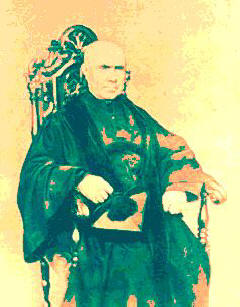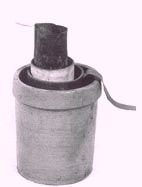Nicholas Joseph Callan (1799–1864)
Nicholas Joseph Callan was born on December 22, 1799, the fifth child in a family of six or seven, at Darver, between Drogheda and Dundalk. )Biographical details of Callan are taken from McLaughlin 1965 and Casey 1985.) His initial education was at an academy in Dundalk, run by a Presbyterian clergyman, William Nelson. His local parish priest, Father Andrew Levins, took him in hand as an altar boy and Mass server, and saw him start the priesthood at Navan seminary. He entered Maynooth College in 1816, and was to remain there for almost all of the rest of his life.

In his third year at Maynooth, Callan studied natural and experimental philosophy under Dr. Cornelius Denvir, who was later to become Bishop of Down and Connor. Denvir introduced the experimental method into his teaching, and had an interest in electricity and magnetism. After ordination as priest in 1823, Callan went to Rome, where he studied at the Sapienza University, obtaining a doctorate in divinity in 1826. While in Rome he became acquainted with the work which had been carried out by Luigi Galvani (1737-1798), and by Alessandro Volta (1745-1827), pioneers in the study of electricity. On the resignation of Denvir, Callan was appointed to the chair of natural philosophy in Maynooth in 1826, and he remained in that post until his death in 1864.
Callan's major claim to fame is as the inventor of the induction coil. Following earlier experiments, he discovered in 1836 that, when a current sent by battery through a "primary" coil (a small number of turns of thick copper wire around a soft-iron core) was interrupted, a high voltage current was produced in an unconnected "secondary" coil (a large number of turns of fine wire). Callan sent a replica of his coil to William Sturgeon (1783-1850) in London in 1837, and it was exhibited to members of the Electrical Society there to their great amazement.
In view of the great importance of Callan's invention of the induction coil, one might wonder why he was forgotten, and his invention attributed to a German-born Parisian instrument maker, Heinrich Ruhmkorff. The answer is simple. Maynooth was a theological university where science was the Cinderella of the Curricula. Callan's colleagues often told him that he was wasting his time. In such an atmosphere Callan's pioneering work was simply forgotten after his death. Like all instrument makers, he put his name on every instrument he made. "Ruhmkorff Coil" got into the textbooks. It was never challenged until Professor McLaughlin published his researches on Callan's publications in 1936, which incontrovertibly proved that the inventor of the induction coil was Nicholas Callan of Maynooth. The first acknowledgement of Callan as its inventor was in the 1953 edition of Gregory and Hadley's Textbook of Physics, revised by George Lodge, Senior Science Master at St. Columba's College, Rathfarnham.

While working on electro-magnetic engines in 1838, Callan may also have discovered the principle of the self-excited dynamo, though he did not follow up this line of research. In his words, he found that "by moving with the hand some of the electromagnets, sparks are obtained from the wires coiled around them, even when the engine is no way connected to the voltaic battery".
With the need to produce reliable batteries for his researches in electromagnetism, Callan carried out important work in this area, inventing the "Maynooth" battery in 1854, and a single fluid cell in 1855. Previous batteries had used expensive platinum, or unsatisfactory carbon, for one of their plates, and zinc for the other. Callan found that he could use inexpensive cast-iron instead of platinum or carbon. In the Maynooth battery, the outer casing was of suitably treated cast iron, and the zinc plate was immersed in a porous pot in the centre. This required two different fluids, on the inside and outside of the porous pot. But he found also that he could make a simple and useful battery by dispensing with the porous pot and the two fluids, using a single solution. In the process of this work, he discovered and patented a means of protection iron from rusting.

Connect with us
Contact us today